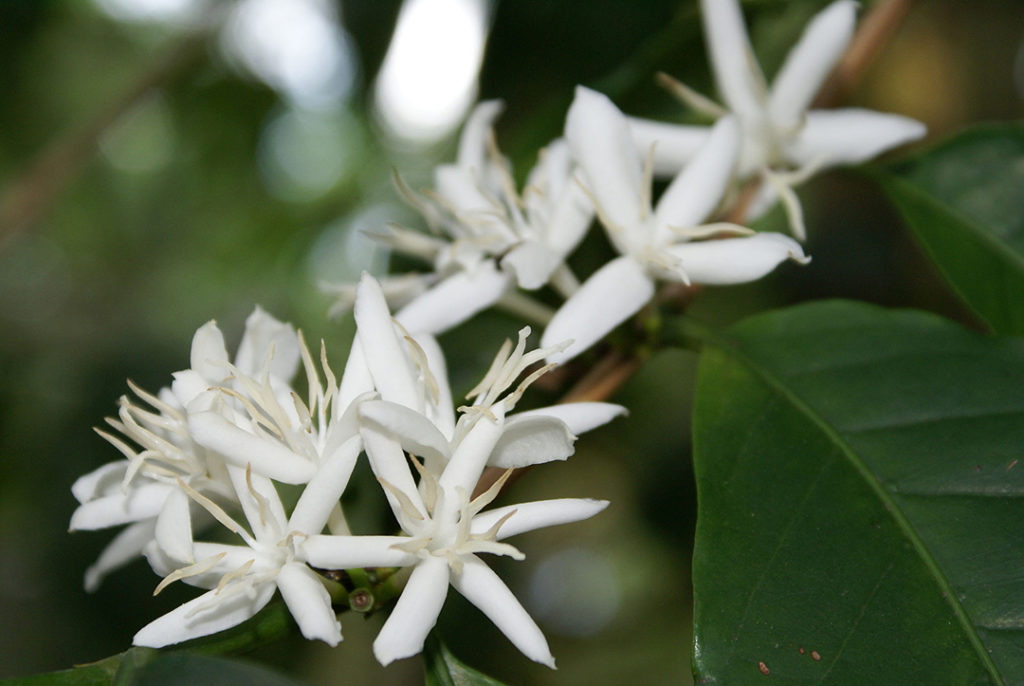
Costa Rica
Coffee Flower
Coffea

General Description / Cultural Significance
The coffee plant has played a significant cultural role in Costa Rica for hundreds of years, and in some way, the plant involves almost all the citizens in the country. Coffee flower is a significant scent in Costa Rica, and Coffea arabica makes up 71% of all the world’s coffee. It is actually illegal to grow any kind of coffee other than Arabica in Costa Rica, as this is the highest quality kind. Costa Rican coffee is known for its rich full flavors. Coffee beans are often plucked and processed by hand from the plant, and farmers take great pride in this. The dried seeds are roasted and ground, then brewed into coffee. Coffee is used as flavoring in many desserts and candy, and overall, it is an excellent source of caffeine. It is known to be a stimulant, and to reduce headaches.
Climate Change/Conservation Status
Costa Rica’s combination of environmentalism, effective policymaking, and practice have merged to make it a country worth emulating. In the 1940’s, over 75% of the country’s woodlands, primarily tropical forests, were devastated by unchecked logging. Conservation International describes the country’s transformative actions to combat the exploitation of natural resources: “First, it diminished deforestation, increasing forest cover from just 21% in 1987 to over 50% by 2005. Now, Costa Rica has directed its attention to another natural treasure: the sea. Addressing threats such as overfishing, illegal fishing and mangrove degradation, the tropical country continues to show the world how the protection and restoration of nature can enable growth and prosperity.”
Costa Rica is now focused not only on preserving their status as one of the earth’s most biodiversity rich countries, it has brought national awareness to its endemic flora. However, like many other biodiverse nations, it is under some of the most severe threats of climate change. Its cloud forest, Monteverde, a tourist destination for the world, is experiencing such high temperatures that it has become hard to distinguish it as a cloud forest. As temperatures are increasing, both animals and plants are moving to higher elevation, but some can go no further.
Preserving the tropical forests and native plants that provide both food and nesting sites for bees has proven to be an extremely wise conservation measure. Forest bees need mature trees for their nesting sites. Over 400 species of bees that are native to Costa Rica and additional pollinators are among the healthiest in the world. These bees, which are vital resources to the coffee farms, have thus far been more insulated from climate change than in other countries. Scientists have projected that the mountainous areas of Costa Rica may stay cool enough in the immediate future to support coffee growth and essential bee populations.
In 2019, Costa Rica announced that it will strive to be free of fossil fuels by 2050. To address the effects of global warming, it will use chiefly hydropower, but also wind, solar, and geothermal energy. The New York Times positions Costa Rica to be a model for developing countries to grow their economies through decarbonization strategies.
Despite Costa Rica’s exemplary efforts to conserve biodiversity, the effects of the climate crisis are taking its toll on the coffee plant. Increased temperatures, extreme changes in rainfall, and an ongoing battle against a beetle called the coffee berry borer have resulted in an extreme drop in overall coffee production nearing 50%. The ideal growing conditions for Arabica coffee plants are between 64 and 71 degrees, and temperatures that move out of that range interfere with photosynthesis and the transfer of nutrients. Temperatures are unfortunately rising.
Alternate Names
Arabian coffee
Sources
Cimons, M., 2017. The bees behind your morning coffee might be in big trouble. Recurrent. [website]
Conversation, n.d. Conservation International Costa Rica. Conservation International. [website]
Permanent Mission of Costa Rica to the United Nations. This statement can be found on the World Sensorium original website.
Sengupta, S., & Villegas, A., 2019. Tiny Costa Rica Has a Green New Deal, Too. It Matters for the Whole Planet. The New York Times. [website]
Zúñiga, A., 2016. Dealing with climate change in Costa Rica’s treasured Monteverde cloud forest. The Tico Times Company. [website]

